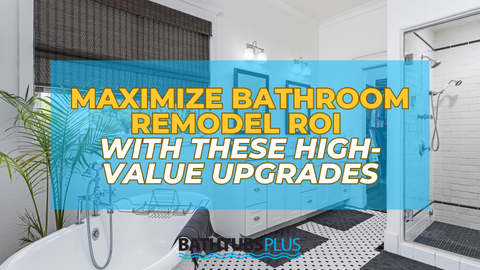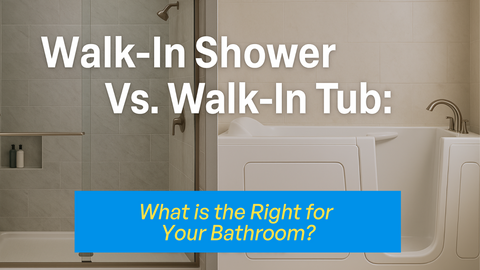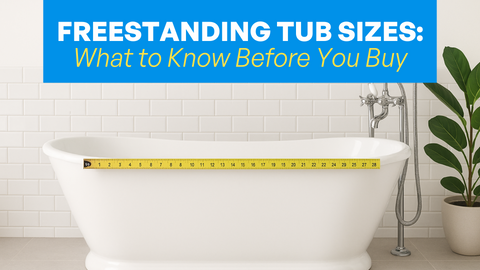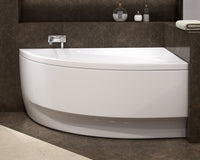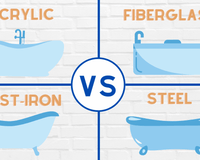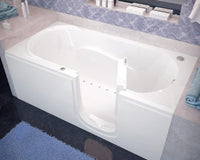Bathtub shopping can be fun until you’re faced with a dizzying array of choices that makes deciding extra hard and time-consuming. Whether remodeling an older bathroom or building a new one, you want to make the best bathtub selection the first time around.
Design, functionality, material or price– whichever your priority may be, it’s best to review your options and think long term. Don’t limit yourself to one type, or you might find yourself ripping out and replacing your tub a year– or worse– just months after the purchase.
Escape the buyer’s dilemma with this simple yet comprehensive bathtub guide that will make your shopping more convenient!
| Table of Contents |
What are the Factors To Consider When Buying a Bathtub?
1) Bathtub Features
First things first: what’s the purpose of your tub? Some want it simply for their everyday bathing utility, others want to make it as indulging and relaxing as possible. From here, you have two general options– get a Soaker, just-water tub or a Jetted tub–with blowers, bubbles and a whole massage system.
Soaking Tub

Soaking tub is a tub that simply gets filled with water for an occupant to soak in. It has extra-deep dimensions to completely submerge the bather in shoulder-deep water. Soakers are designed to accommodate a full-body soak that’s why they are deeper than regular tubs. Its standard soaking depth (measurement of the tub’s inside walls, from base to the overflow drain) is 16-17 inches and can go as deep as 22 inches like the Japanese soakers, depending on tub design or shape.
Why love it?: The soaking tub is easily a bathroom oasis that’s perfect for a long, peaceful relaxation. It can hold 60 to 250 gallons of water compared to average tubs who can only handle between 25 and 45 gallons, giving you a hydrotherapy treat that can soak your stress away in its pool of calming and pristine water. Its spacious structure can also accommodate people with heavier builds, like the Meditub soakers which can handle up to 500 lbs of weight.
Special considerations: Filling a soaking tub requires more water than a standard tub, so it's something to consider for the water bill or if you live in drought areas. Its deep structure may not be suitable for young children or people with limited mobility unless it’s a Soaker Walk-in tub, which lets the bather sit in the tub while soaking.
Jetted Tub (Air or Whirlpool)
Unlike the water-filled soakers, some tubs come with jets. Like the Air tub whose jets blow gentle air for lighter massage, or the Whirlpool with jets that shoot water for a more invigorating pressure. Each offers a different kind of therapeutic relief and can effortlessly turn your bathroom into spa-like sanctuaries.
Air Tub

At first glance, an air tub is just like your typical tub except it has air jets that blow smooth air that upgrades the usual bathing experience into a mind-soothing journey. How so? The soft stream of heated air coming from its jets produces millions of massaging bubbles that can completely wallow the bather in its authentic cuddle.
Why love it?: You’ll easily love the air tub because it can give you a spa-like bathing experience you won’t get anywhere else. If you’re someone with a pretty hectic schedule, this tub is a cheaper alternative to your luxurious spa needs.
Not only that, Air tubs are equipped with Aromatherapy features, giving you the luxury to enjoy scented oils and bath salts as you bathe. Daily dip in this effervescent pool will leave your skin glowing and raise your mood-booster hormones, Endorphins (great self-care treat after a stressful day!). It also comes in an assortment of styles and installation types like the freestanding, alcove, corner, to match your bathroom’s layout.
Special considerations: Air tubs cost much higher than a standard tub, with prices ranging from $1,000 to $15,000. (See more affordable yet quality brands here.) It may not be the most practical choice, but if you have extra cash, getting an air tub is a good deal given the countless health benefits it offers. The blissful bath it gives is pretty much the same leisurely experience you can get from your local spa, but cheaper! Surely, the price you pay is worth it.
Whirlpool Tub

Whirlpool, or its household name Jacuzzi, is a water-jetted tub that gives off a deep and targeted hydro-massage that’s best for soothing the stressed regions of your tired body. The powerful blows of water from its jets will not only massage your pain points, but will also slowly overwhelm your senses which is a great way to calm the mind after an exhausting day.
It’s a great buy not merely for its spa-like features; it’s beneficial for your health, too! A lot may not know but the tub was initially built to provide medical relief by one of Jacuzzi tub’s Italian inventors, Candido Jacuzzi. Hoping to improve his son’s rheumatoid arthritis, he designed the first ever water pump, the Jacuzzi® J-300™, that could be submerged in a bathtub and provide hydrotherapy treatments. To this day, the wonders of whirlpool are still widely acknowledged and used by many hospitals and medical facilities.
Why love it?: Whirlpool is great for all weather and events– may it be for a private, social, serene or fun bathing experience. Whether you want to chill on a summer’s day or shake off the cold of the winter night, a soak in a whirlpool will do the trick. The best part is, it can treat some bodily ailments and is good for healing sports-related injuries, easing tensed muscles, and improving joint pains.
Special considerations: Similar to air tubs, whirlpools can produce a bit of noise (around 70-80 decibels), like the noise a normal traffic or a quiet train makes, depending on how fast the pumps work. Some whirlpools can also be hard to maintain, but if used on a regular basis, there will be less bacteria buildup. Don’t fret as there are lots of cleaning tips available online, and even better, self-cleaning whirlpools that make bathtub maintenance less of a work.
Like air tubs, whirlpools are more costly than regular tubs, with prices ranging between $2,000 to $10,000– the more features, the more expensive. You may get cheaper rates from sellers who decide to dispose of them or find pocket-friendly whirlpool tubs here at BathTubsPlus with our year-round sale.
Combo Tub
Torn between the two jetted tubs? Read Air Tub Vs. Jacuzzi Tub: What’s the difference or perhaps combine the features of an air tub, whirlpool and even soaker in one, which many modern tubs offer these days. Just a friendly reminder: the number and locations of jets, pumps and blowers are usually predetermined and cannot be changed, so we suggest you coordinate well your particular needs with the manufacturer or seller.
Also note that a soaker, air and whirlpool are hydrotherapy features that can go with different tubs. So it’s possible to have a freestanding tub that’s only for soaking, or either has Whirlpool, air or combo jets. As you go through this guide, you will better understand the design, shape and installation variations of a soaking, whirlpool, air and combination tubs.
2) Bathtub Design and Form
Choosing whether you want to just enjoy a nice soak or install massage systems in your tub is only the start, it’s also important to consider which design suits your needs and lifestyle. May it be for functionality, comfort or aesthetic— there are all kinds of tubs out there to meet your specific tub requirements.
Walk-in Tub

Walk-in tubs offer functionality and comfort in one package. It has unique and accessible designs not all bathtubs can provide, with safety features for added security like low step-in doors, sturdy grip bars, non-slip floors, ergonomic controls, and ADA molded seats, to name a few.
Why love it? You can never go wrong with this tub if safety is your top priority. Its well-engineered structure best accommodates elderly or people with limited mobility at home. It has two-person, chair-height and even wheelchair-accessible models for those with special bathing needs. You can also add massage systems and other accessories to further elevate the experience. This tub is typically installed in an alcove so it also won’t take up much of your space.
Special considerations: Walk-in tubs can get a bit more expensive, with prices ranging from $3,500 to $5,000. Prices go higher when additional hydrotherapy jets and bath luxuries are installed. You may have to increase the budget, but getting a walk-in tub is a wise investment in the long run, especially if you plan to age in place or you’re a caregiver of senior citizens.
Clawfoot Tub

If you're a vintage kind of person, you would love the classic and ageless beauty of a clawfoot tub. The tub’s key feature is its signature feet or “claws”, which makes it distinct from the more minimalist bathtub models that are either dropped-in or stand on a pedestal. Clawfoots rest on either a contemporary, stylish legs, or traditional, monarch feet which exude Victorian Era vibes. It’s a perfect statement piece if you opt for a more elegant and classy look for your bathroom.
Why love it?: Clawfoot tub gives you more freedom to design your bath space, as it is a freestanding tub that can be independently placed anywhere. It works magically well wherever you want it to be installed, may it be parallel or perpendicular to a wall, or even in the middle of your master bathroom. It has a lot of color and design variations too that can easily match any bathroom style or layout. Revamp your bathroom now with its intricate details and eye-catching sculptural design.
Special considerations: Most clawfoots are made out of cast iron which is a relatively heavier and more expensive material. You can find other lightweight and cheaper materials for this tub, but cast iron is surely a durable material that’s proven to last longer.
This tub is also taller and longer due to its feet. They typically range from 54 inches for smaller tubs and 72 inches for oversized tubs, so it’s something to consider if you have limited bathing space. Before picking this tub, consult a plumber and check if your bathroom foundation can hold the tub’s weight, and see whether a pedestal tub is a better option.
Slipper Tub

Slipper tubs, a.k.a. high heel pump, is famous for its sloped form that’s higher on one end like a slipper–where its name was basically derived from. This tub flaunts a visually-striking design that takes you back into the 19th century. It can come in either a single slipper (one high end) or a double-slipper (two high ends)-- which can accommodate two persons. Similar to clawfoot’s design, slipper tubs give off a lavish and elegant aura that’s best for fancy and romantic wine nights.
Why love it: Aside from its charming vintage appeal, the slipper tub is ergonomically shaped due to its reclining ends. This can comfortably accommodate the head, neck and spine of the bather. Most slipper tubs are made out of cast iron, so it’s a good option if you’re eyeing for a more durable and maintainable tub that can withstand the test of time. It’s also an excellent insulator that retains heat longer so there’s no need to continuously refill the tub. They come in either feet or plinth so you have more styles to play with.
Special considerations: Slipper tubs are not only heavier, they can also be longer and wider given its structure. They are generally 30 to 80” long, 19 to 67” wide and up to 36” deep. It can serve as a beautiful centerpiece for large bathrooms, but can look cluttered in tiny spaces. Similar to clawfoots, this tub has cheaper and more lightweight variations made out of acrylic, but it won’t be as heavy-duty as those built with cast-iron or copper bronze.
Pedestal Tub

True to its name, pedestal tubs are tubs that are raised by a plinth or a pedestal. It’s fast becoming one of the most popular bathroom trends today, given its sophisticated and modern look that outgrowns the clawfoot’s ‘feet’. The tub’s pedestal acts as a base for the tub’s body or simply to support uneven floors.
Why love it: Installation for this tub is easy, as it doesn’t use the-drop in or alcove method. Simply place the tub wherever you’d like it to go in your space, connect to water lines and enjoy! It’s perfect for larger bathrooms too, for it is naturally designed to be a classy centerpiece. Its bulky and spacious build also allows couples or two bathers to enjoy the tub together. Like other tubs with cast iron material, a pedestal tub can keep the water warm for longer, more relaxing baths.
Special considerations: Its heavier and bigger variations may pose space and weight constrictions, depending on your floor space. This type of tub is a tricky fit in apartments, but can be a fantastic option for single-family homes and larger condominiums. Its flexible installation makes it easy to place around the room, unless you encounter problems with your plumbing lines.
3) Installation Types
Your bathroom configuration– the bathroom’s floor space, layout, plumbing and drain placements dictate which bathtub installation will be apt for your home. Some tubs can be more flexible, while others go only with certain types of installations.
This step may be the priority for some homeowners; it really depends where you’re coming from. You can be more versatile with your bathroom installation if you’re building your bathroom from scratch, but it can be more challenging for those doing home remodeling due to the existing walls and plumbing.
See which tub installation is best for your bathroom:
Freestanding Tub

A freestanding tub can freely stand alone anywhere in your bathroom as it is finished on all sides. Lingering in your tub through your window is possible with this tub, as long as the plumbing is adjacent. It doesn’t need any enclosure unlike other tub designs, giving homeowners more flexibility in decorating their space. It’s also accessible from all sides so going in and out of it won’t be a problem.
Best for: People who want their tub to be the focal point of the room and easily make a statement. It has a variety of designs and finishes to blend your bathroom decor– from the classic claw-foots to the modern oval-shaped soakers. Given its hassle-free installation, there’s no need for a decorator or a contractor; a plumber will do.
Drop-in Tub

Drop the hassle with a drop-in tub! This tub is painless to install for it can be ‘dropped’ anywhere, as long as there is proper leveling and a well-built frame for it to settle. Contrary to a freestanding tub, its unfinished exterior explains why it’s made to be hidden and ‘dropped’ in a stone or tile surround. Its deck or sides can serve as a functional space for placing soap, candles and other bath essentials. (talk about maximizing your bathroom space!).
Best for: Bathrooms with pre-existing foundations constructed ahead of time. Without the need for wall confines, drop-in bathtubs have greater flexibility in size, meaning they can be much bigger than alcove bathtubs. If you love long hot baths, the deck set up adds insulation to the tub which can keep the water’s heat for a longer duration.
Easier to clean too! When you plan to take more showers, a drop-in tub keeps the water off the floor better than a freestanding wherein the shower water is more likely to splash out the tub, unless a shower curtain is installed around it.
Undermount Tub

Undermount and drop-in tubs can be quite similar apart from a few subtle differences. Both have a deck surrounding the rim that’s made of your chosen material– either a stone, tile or any solid surface. Undermounts are placed beneath the rim so that the bathtub’s weight is distributed between the floor and the rim. Meanwhile, drop-in bathtubs are installed above the rim, resting much of their weight on the rim itself. Aside from this, tubs with under-mount and drop-in installations are nearly identical in terms of price, design and size.
Best for: Those who want a more seamless installation than that of a drop-in. Because a drop-in bathtub is installed above the rim, it has a raised lip and visible sides, whereas the undermount’s edges are hidden from view– much like an infinity pool when filled with water.
Alcove Tub

The space-savvy alcove tub is practical for small bathrooms due to its highly efficient design. It's a recessed tub that is enclosed by three joining walls, and is typically placed in the bathroom nooks they’re built for. It makes a bathroom more spacious as it runs flush with the bathroom wall, unlike freestanding tubs which occupy more floor space.
Best for: Homeowners who want to maximize their available bathroom space. Alcove tubs have a standard dimension of 60 inches long (5ft), 30 inches wide (2.5ft), and 16 (1.3ft) inches of water depth. This installation best works for tub and shower combos due to its more compact structure. It makes life easier too as you can conveniently reach and clean its corners and walls.
Apron Front / Skirted Tub
An Apron-front is very similar to an alcove, except its front and one ends are exposed with either a flat or bowed skirt. This skirt covers the entire length of the bathtub with the intent of providing an area to rest on and making it much easier to install.
Best for: Small living spaces that need a space-efficient yet more versatile bathtub. Compared to an alcove, this type has two ends finished giving you more leeway in decorating your space. It’s not only meant to be put in three-walled spaces, so fitting it in a corner is possible.
Corner Tub

A corner tub is a bathtub with three or five sides, designed to fit into corners. It allows homeowners to install a bathtub in locations that would be impossible with other bathtub shapes. It can be larger on the inside too, some accommodating two bathers at once. Best for: Homeowners who want to efficiently utilize corners, odd angles, or dead space in their homes. If you want to add other vanities in the bathroom, having this tub frees up bathroom floor space, and provides more space in the room’s center.
4) Bathtub Shapes

The tub’s shape is a vital factor to consider not solely for people’s visual interest but for a whole lot of practical reasons. Some shapes are more ergonomic and thus more comfortable for the occupant, some more space-savvy, while others are simply uniquely and stunningly-designed. Spruce up your bathroom with these fun yet functional tub shapes:
Rectangular
- Features a more contemporary design that follows the latest trends in bathroom decor
- Versatile and space-saving; good option for people with limited bathroom area
- Its clean and linear appearance is perfect for minimalist-styled bathroom
Seen in: Reliance Skirted Soaking Bath
Oval Tub
-Also known as egg-shaped tubs and are often seen in pedestal tubs
-Best for full-body soak as the shape cradles the body's form for maximum comfort
-Usually heavier so better check if your floor can adequately hold its weight and that your preferred placement allows enough room for it
Seen in: Venzi PietraStone
Round Tub
-Seen in soakers; built deeper for an upright bathing experience
-Does not take up much floor space due to its compact structure.
-Visually striking as it contrasts the usual straight lines of a bathroom– linear walls, floors and countertops
Seen in: Aquatica Mini Freestanding Japanese Soaker
Hourglass Tub
-A tub that curves in the center, forming an hourglass or a figure 8-like shape
- Not only visually appealing, it has an ergonomic shape whose sides may serve as armrest
- Its design makes it easily a focal point in the bathroom, especially if it’s a freestanding
Seen in: Venzi Velia
Square Tub
-Sides are equal in length, usually with a deep interior like a round tub
-Often sunken and installed undermount
-Space efficient; sits comfortably along walls and in corners without wasting space
Seen in: Venzi Grandtour Capri
Mix and Match
You see, that’s the beauty of owning a bathtub– you can choose your best-loved features and enjoy them all in one! Just like how a Freestanding tub (installation) can both be an Oval (shape) and Clawfoot (design), and can even have air jets (hydrotherapy feature). Do your own mix and match, and find the one that suits your special needs, comfort, aesthetics and budget.
Valuable Tips for Smarter Bathtub Shopping

1) Weigh the weight – and size (What is standard size for bathtub?)
Know the tub’s exact dimensions before finalizing your choice. A lot of factors dictate the tub size that’s most fitting for your home: your floor space, the occupants, bathroom accessories to be included, etc.
More space means more freedom to choose bigger tubs. But for homes with smaller bathing areas, compact and space-saver tubs like Alcove,Corner and Rectangular are more efficient. Large tubs in tight spaces will not only make your bathroom look cluttered and unappealing, it may also cause you inconvenience and discomfort.
Bathtubs can be pretty heavy too, so it pays to know if the floor can support and hold the weight of not just the tub, but also its overall weight when filled with water and when someone’s inside. Don’t forget to measure your bathroom doorway as well to ensure that the tub can pass through!
2) Figure the bathroom configuration (What should be the bathroom size for bathtub?
Your bathroom configuration plays a vital role in choosing a bathtub as it determines the overall layout for your tub.
If you’re remodeling your bathroom, it’s best to pick a tub that has a similar configuration with the existing tub–with the drain and faucets roughly in the same location. Installing a tub against a wall, where the existing spout and drain are, is a more convenient option unless the plumbing lines need to be relocated.
Determine also the drain and overflow placement that will best work for your bathroom. These holes are prefabricated so they cannot be adjusted once built. If your chosen tub’s drain location doesn’t match your bathroom, workarounds can be made like building a higher platform so the drain can run under the tub and above the floor, or opt for another tub with a different drain location but overall has the same dimensions and features as that with your initial choice.
3) Know the material (What is the best material for a bathtub?)
Tubs can be made out of various materials: some have nice sheen and luster, but are more slippery and hazardous, some are durable but are more costly. Each has its good and bad; gauge which gives the most value for your money.
If you want to save on your bathtub purchase, fiberglass and acrylic are the cheaper options. Tubs made out of these materials are lightweight, making them easier to install, repair and maneuver around a house. These tubs, however, are usually more brittle and porous. Porous materials absorb water, making it more difficult to maintain and clean. Good thing some brands today offer tubs with the same lightweight acrylic material but are far more durable like the brand Acrastone.
On the other end, there are the sturdier and non-porous materials like stone resin, cast iron and copper which are also known to have high heat retention. These tub materials can make your warm baths more enjoyable because they retain heat longer, and your pockets happier as they are energy-efficient. Non-porous tubs are also a lot easier to clean and look spotless for they repel mold-attracting dirt and general bathroom stains.
Cast iron and stone resin are luxurious for a reason. They have a longer lifespan and do not need constant repair, thanks to their low maintenance and scratch-resistant material. The downside of these durable tubs, however, is that they are incredibly heavy. They can be heavy in the wallet too, considering all the additional labor and materials needed for the tub’s support and overall installation.
4) Prioritize the non-negotiables (What do you need in a bathtub?)
Know your priority when it comes to your bathing. Safety, comfort and convenience are the usual non-negotiables that people put in the line first. Do you have older parents that will use the tub? Does your physical condition require a more accessible tub? Any kids that will use it? You’ll be soaking in your chosen bathtub for quite a good time so better take all factors into consideration before checking out.
If comfort is what you’re looking for, we recommend that you go on site, test drive the tub, and see for yourself if it’s ergonomic enough for you. Be certain about the tub’s dimensions and parts, especially if the bather has physical limitations. How low is the step in? Will a wheelchair fit in the tub? Is the tub’s walls too high for my elderly mom? Can the tub’s swing doors fit in this particular space? It becomes more complex when the user has special bathing needs, but all these must be factored in and be well-coordinated with the bathtub seller.
5) Sum it up (How much should a bathtub cost?)
Looking at the price tag is not enough to tell right away whether a tub fits your allotted budget. Having a bathtub at home entails other costs that you must be prepared to shoulder. Prices of tubs can range anywhere between $900 to as much as $14,000–the more elaborate the tub, the more expensive. Good thing some tub materials are built to retain heat and thus conserve water and electricity. Some tubs are also equipped with cost-efficient technologies so you can save dollars in the long run.
Review thoroughly the specifications of the tub and know how much electric power it needs to run, how much water it takes to be filled, and other fees that you must be aware of. Some installations may also require additional costs whether it be for adjusting plumbing lines or building the tub’s deck.
Buy a Bathtub Online at BathTubsPlus
Buying a bathtub is one of the vital decisions you’ll make for your home, more so for the people who will use it, so it’s definitely important to know the nitty-gritty of it.
Already have your ideal bathtub in mind? Choose among our reliable and trusted bathtub brands–some of the best in the industry– and whom we work closely with to ensure that we give our customers only the best prices, selection and service possible.
For more questions and concerns, email us at: sales@bathtubsplus.com or reach us here. Your bathtub needs matter and BathTubPlus is always happy to assist!





